-
Posts
2,284 -
Joined
-
Last visited
-
Days Won
6
Content Type
Profiles
Forums
Blogs
Gallery
Events
Store
Posts posted by PKeating
-
-
I concur with Paul. It looks perfectly OK but any example commanding a substantial price ought to have the top suspender. Gosh...I remember when one could pick these up in London antique markets for around ?15.00 or ?20.00. I think Ireland's escapist attitude to her looming economic troubles, some smart types with a talent for hype, the 90th anniversary and a rash of people with more money than sense caused the enormous hikes in prices.
Interestingly enough, I approached Whyte's last year with a stone proof of a portrait of Sir Roger Casement, done in Dresden during Casement's last visit to Germany just before the Rising. The stone proof - a unique item - was done for a German propaganda book of the time and ended up in the collection of the director of the hotel where Casement stayed. Gustav R?cker collected autographs of some of the interesting people who stayed at the Europa Hof from the WW1 era to the 1930s and I have the collection. So, yes, the print appears to be signed by Casement. Whyte's estimate? About ?200.00. This was in the run-up to that Uprising sale. I had actually made a bet with a friend who was pushing me to cash in on the whole 90th anniversary hype that this would happen when I 'came from nowhere' and asked the auction house about this piece. Had I been a dealer or someone better-connected with them, I expect the estimate would have been somewhat higher. Not that I wish to cast aspersions. Maybe the chap at Whyte's failed to grasp the historical importance of the piece... But I won my bet, which I made on the basis of my highly jaded attitude to auctioneers in general.
At the end of the day, far more of these medals were minted than ever awarded. Of course, a set with verifiable provenance and related ephemera will always have a substantial value, particularly if the recipient happened to be well known or well-connected. However, I would challenge $500-plus for an unattributable, incomplete War of Independence Service Medal.
PK
0 -
106 honorific awards of the PO Badge in the nine months of 1943 up to September... Hmmmmmm. Regarding the question of a special solid gold PO Badge, one cannot discount it, given G?ring's penchant for expensive gewgaws. So far, we know that Otto Skorzeny received some form of flight badge because his SS personnel file confirms it and it is supported by anecdotal evidence. It is obvious that this must have been an honorary award of the Pilot-Observer Badge because, as far as I know, Skorzeny did not hold any form of pilot's licence. It is interesting that the awards on his funeral cushion include a rather normal-looking PO Badge. Had Skorzeny been a holder of the PO Diamonds Badge, this would surely have been included with the awards displayed, even if the original was lost, because replicas were available when Skorzeny died. The cuff title is a fantasy piece. I haven't found any evidence of an award of the Ehrenblattspange but that does not, of course, mean that he did not receive it. Skorzeny also held the SS Old Fighters' Chevron and the Reich Sports Badge in Silver.
PK
0 -
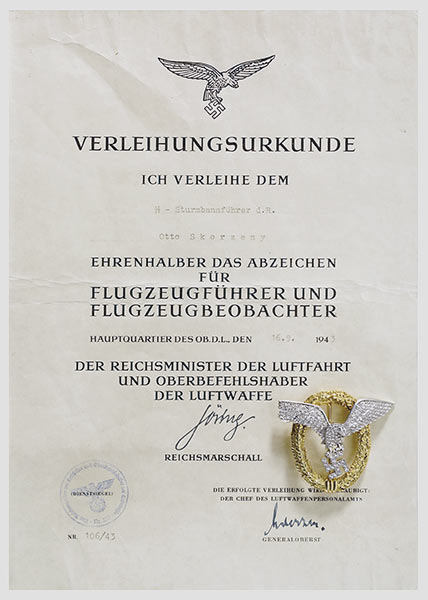
Well-spotted, Chris. Must be all those aluminium messtins I ate from promoting premature senility! I've never seen a document for the Diamonds badge but yes, this document is for an honorary award of the Combined Pilot-Observer Badge and would tie in with Skorzeny's own recollection, when interviewed in the 1950s by Charles Foley, of receiving an honor award from G?ring at Rastenburg just after Gran Sasso.
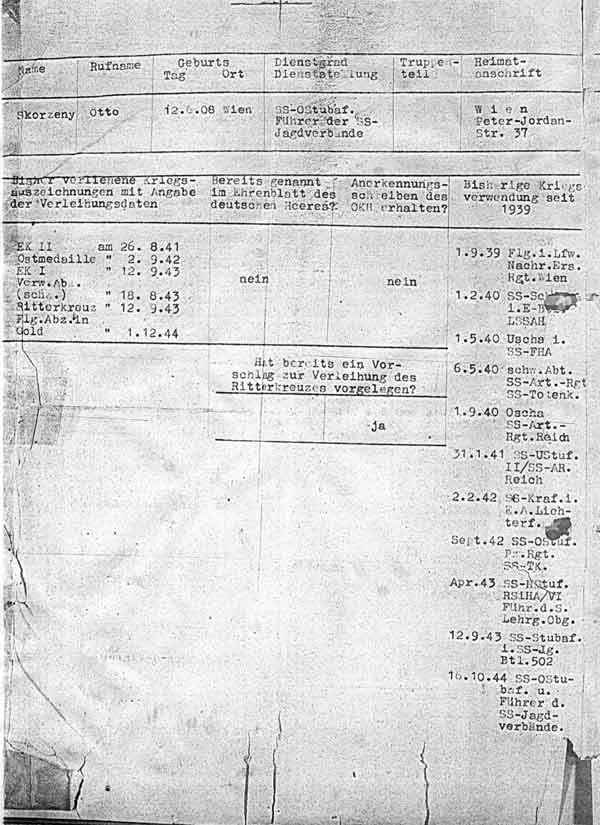
If the entry in Skorzeny's personnel file for the award of the "Fliegerabzeichen in Gold" on 1.12.1944 relates to the Combined Pilot-Observer Badge with Diamonds, then Hermann G?ring must have awarded it to Skorzeny for the coup d'?tat in Budapest, codenamed Unternehmen Panzerfaust. If so, it is ironic that the man Skorzeny toppled, and whose son he kidnapped, was a recipient of the PO Badge with Diamonds. Maybe Fat Hermann told Skorzeny he could have Admiral Horthy's badge...
There again, why is the September 1943 honorary award of the PO Badge not included in his personnel file? Of course, many personnel files are remarkably incomplete when it comes to details like awards but Skorzeny's file doesn't appear to fall into this category. It is quite detailed. Is the award date an error? Was the badge to which the file refers just an honorary PO Badge? Did some smart alec decide to interpret this SS file entry as meaning that Otto Skorzeny was awarded the PO Badge with Diamonds, in order to pass a well-made fake onto the market?
None of this is new. In a letter to a militaria magazine in 1981, as Chris relates in one of his books, Andrew Mollo expressed his belief that there was a third - solid gold - grade of the honorary PO Badge awarded to Heinrich Himmler. The above file was prepared by the staff of the RF-SS so perhaps they were in the habit of referring to the PO Badge, with or without the diamonds, as the "Fliegerabzeichen in Gold", because of the colour of the wreath. And perhaps this led to Mollo's theory that there could have been a third class of the badge.
As for the Skorzeny award document, I would, as I said, have expected to see G?ring's embossed seal on a document of this kind rather than the ink stamp. I am not even sure that Skorzeny managed to hang onto any of his awards or paperwork. How much of the stuff on it was even original? Leaving aside his incarceration as a suspected war criminal, US and British security services turned his homes over several times in their frantic search for evidence to make the war crimes charges stick. Otto Skorzeny was considered the most dangerous man in Europe, especially in that delicate period after the war. When Skorzeny was sprung from prison, it is highly unlikely that he took anything incriminating with him on his escape to Spain.
PK
0 -
That is logical. Wever and Milch died prematurely and their badges were probably returned to the Reichsmarschall's office. If these first three badges were made of superior metals - 916 gold - to later badges in 585 gold, it would be unsurprising that the pathologically acquisitive Hermann G?ring kept the Wever and Milch badges for himself, awarded slightly cheaper but just as beautiful A-St?ck badges in 585 gold instead, perhaps with white gold eagles.
Regarding the question of platinum eagles, it should be borne in mind that platinum was indeed a precious metal but before the vast majority of stocks were reserved by the Space industry, it was seen as on a par with silver. It was popular for setting diamonds and other stones because of its relatively hard-wearing nature and resistance to oxidisation. Indeed, Tsarist Russia was using platinum for coinage well into the 20th century. Platinum as an exotic material is a comparitively recent phenomenon. It is 'rare' for the reason that diamonds are 'rare', because supply is highly controlled.
If none of the eagles of known originals bear platinum hallmarks, I would suggest that this is because they were actually made from white gold and the view was taken that a single hallmark would suffice. In support of this, I would refer to two-piece badges struck in silver for private purchase by C E Juncker, like the Pilots Badge and the Army Parachutist Badge. These bear just one silver mark. I expect that if examined, the A-St?ck badges were made of yellow and white gold to achieve the two-colour effect.
PK
0 -
That's a perfectly reasonable question, Stan. The ELSuB was a state award and requests for duplicates were made in the same way that any Ritterkreuz-related request was made after the rules regarding supply of the RK and its various "add-ons" were tightened in 1941.
The Combined Pilot-Observer Badge with Diamonds was, however, a personal award instituted by Hermann G?ring and the A-St?ck award badges remained the property of G?ring's office, the rules requiring return of the badge when a recipient died. I think the families would have been allowed to keep the silver-gilt B-St?ck badge.
At a stretch, one can envisage certain recipients, such as foreign royalty, nobility and heads-of-state commissioning copies of the badge from local jewellers but why would they bother? They did not as a general rule, as far as I am aware, commission copies of other orders and decorations. Furthermore, G?ring anticipated the need to take good care of the A-St?ck badges by giving recipients the silver-gilt dress copies. If Italian, French or Bulgarian recipients had done so, I am sure there would be a general awareness of variant badges bearing the appropriate hallmarks of the countries in question.
Were a badge lost, I daresay that a recipient could request a replacement but, as you say, there does not seem to be any documentary evidence available in relation to this. Making such a request would have been rather embarrassing and might even have resulted in a hefty invoice. You contend that one recipient had three A-St?ck badges in his possession. If this individual managed to get three such badges out of G?ring's office, he must have been important enough to get away with two reports of losing the highly valuable insignia with which he had been trusted! So, who was he?
A German recipient unfortunate or careless enough to lose his A-Stuck badge might have been tempted to have a replacement made but this brings us back to the question of whether any jeweller in the Reich or its territories would want to involve himself in replicating an award in the personal gift of the Reichsmarschall. Unofficial or semi-official though the award was, it was still G?ring's 'territory', so to speak. Moreover, G?ring was known to take a keen interest in the quality of awards, as the anecdote about the ELSuB in Adolf Galland's memoirs, for instance, tell us. In fact, it is surprising that G?ring countenanced the setting of the B-St?ck badges with rhinestones. I have handled a couple of A-St?ck badges but never handled a genuine B-St?ck badge so cannot comment on the quality of the stones therein.
I suppose the point I have been leading up to is that private jewellers' copies of Third Reich awards tend to be postwar rather than wartime confections. There are exceptions, of course, like the EL commissioned from a Milan firm by General der Fallschirmtruppe Richard Heidrich but even then, Heidrich seems to have ensured that he had, at least, tacit approval from HQ for this. Japanese-made Iron Crosses are another example of legitimate wartime "jewellers' copies" but they were commissioned by the German authorities in Japan, presumably with the necessary permission to do so. I don't think one can explain away all these different-looking diamond-studded gold and platinum PO Badges to people like Milch, Sperrle, Skorzeny, Horthy and anyone else the fakers think of by saying that they could be wartime jewellers' copies. No Luftwaffe General would have dared to wear an unapproved replica of an award from their sharp-eyed boss!
PK
0 -
OK, so where does that leave us with the Hartmann badge, which reportedly bears just the 585 gold hallmark on the wreath? The Hartmann and G?ring badges, as shown in this topic, appear to be the same. I cannot remember any mark at all on the reverse of the Rudel badge but I handled it briefly as a callow youth almost thirty years ago, before one paid much attention to such details.
PK
0 -
Such damage is often seen on otherwise clean, good badges brought back to the UK by returning service personnel because of the rule stipulating that they could only take damaged stuff as souvenirs. So many of them broke off pins or hooks, or both. Some denazified them, not because of any rule governing the swastika, but because it was a convenient way of damaging the piece to legalise it as a souvenir.
Strange but true.
PK
0 -
Interesting. It rings bells. Remind us: who was the individual in question? Now, do you think the genuine A-St?ck badges were made of gold and platinum or simply of yellow and white 14ct gold? As far as I know, none of the known original A-St?ck badges bears more than the .585 hallmark for 14ct gold. An eagle made of platinum should surely have been marked with an appropriate assay mark like the 950 PT mark seen on A-St?ck RK Brillanten, shouldn't it?
PK
0 -
I'm not convinced that any German jeweller who did not have express permission to manufacture this award would take such a liberty, no matter how high-ranking or exalted his client. The award was a highly personal one from G?ring and recipients apparently received B-St?ck badges with their award pieces. Any recipient wanting extra wearing copies could presumably order them from the approved/recommended source. As for some recipients having more than one A-St?ck badge, how sure can we be of that? The A-St?ck badge was extremely costly and remained the property of the Reichsmarschall's office. It is hard to imagine G?ring's office allowing recipients to have more than one A-St?ck badge each.
PK
0 -
If it's any consolation, replacing originals with fakes is one of the classic scams. It's been done to a lot of German veterans. It has also been done to many museum collections, from the Imperial War Museum downwards. If there is someone out there advertising medal remounting services and switching medals like this, he ought to be exposed for it. Mind you, without proof, one cannot accuse people. If you were done over in this way, it's a very expensive lesson, given the prices these medals are fetching. It is a shame that you did not consign them for auction through Whyte's as they were. Serious buyers wouldn't have cared about rotten ribbons. eBay is really the last place to offer anything nice. Whenever I want to offload something of quality, a successful sale for top dollar is never more than two or three telephone calls away. Mind you, you got a good price for the RDF BWM/VM pair.
PK
0 -
Q: WHY ARE THE RINGS CONNECTING THE RIBBONS TO THE MEDALS SPLIT. I HAVE A NUMBER OF MEDALS NAMED, AND NONE OF THEM RESEMBLE THESE. REGARDS MICK (ARE YOU GOING TO POST THIS QUESTION)24-Mar-07
A: Hi Mick, I have never actually put a new ribbon on a medal but the person who put the new ribbons on these medals told me that in order to attach the ring to the ribbon the medal is removed from the ring and when the ring is attached to the ribbon the medal is then re-attached to the ring so this is why the rings appear split. The answer to your second question is yes; all questions are posted on the auction. Thanks, Brendan.
This is the source, by the way. I'd say that the person who last remounted the medals must have replaced the ones you found in 1980 with these fakes. Hard to prove it for legal purposes, unless you have old, clear photos of the ones found in 1980 but you might get them back if you were to handle this matter Dublin-style.
PK
0 -
In fact, I'd be fingering the guy who spun you that ludicrous story about splitting the rings to fit new ribbons. Sounds like he fobbed you off with that story when you noticed the rings weren't the same. What's this charmer's name? Is he still around?
PK
0 -
C?ad m?le f?ilte romhat, Brendan! Nice to have a fellow Dub here. It is quite obvious from a persual of your eBay sales that you're a straight fellow. Perhaps I am suspicious and even rather cynical but it sounds as if one of the people to whom you entrusted the medals did you over by perhaps swapping the originals you found in that box back in 1980 for fakes. I know what I'd do if I were you.
PK
0 -
I remember that website! I last looked at it about four years ago. So they're both copies and the vendor was 'exaggerating' with his take of finding these in Dublin back in 1980? So much for him...
PK
0 -
The auction was stopped at ?2,700.00 today, with five hours to go, by the vendor. No explanation given. However, I rather like the answer regarding the rings of the medals and how ribbons are fitted.
Question & Answer Answered OnQ: Hi there, looking at the edge of the 1916 medal, is there a seam in the centre (of the edge)running all the way around the medal ? Can you give a precise measurement of the 1916 medal, measuring across from the extreme east tip of the sunburst ray to to the extreme opposite point on the west tip. As a matter of interest the War of Independence medal is the non combattant variety issued to Fianna Eirean, Cumann na mBan, etc. Thanks for your help, Ozzy 25-Mar-07
A: Hi Ozzy, The tip to tip measurement is 38mm, I can?t see a seam running around the edge but I would say the medal has not been cleaned for some years, I have it 27 years and have not cleaned it and when I found it it looked as if it had been in the tin for at least ten years so it?s probably 40 years since it was cleaned so the seam might be there. Thanks, Brendan.
Q: what would you sell the 1916 medal for regards peter 24-Mar-07
A: Hi Peter, Sorry but if they don?t sell in the auction they are going to a Dublin medal collector who wants the pair. Thanks, Brendan.
Q: WHY ARE THE RINGS CONNECTING THE RIBBONS TO THE MEDALS SPLIT. I HAVE A NUMBER OF MEDALS NAMED, AND NONE OF THEM RESEMBLE THESE. REGARDS MICK (ARE YOU GOING TO POST THIS QUESTION) 24-Mar-07
A: Hi Mick, I have never actually put a new ribbon on a medal but the person who put the new ribbons on these medals told me that in order to attach the ring to the ribbon the medal is removed from the ring and when the ring is attached to the ribbon the medal is then re-attached to the ring so this is why the rings appear split. The answer to your second question is yes; all questions are posted on the auction. Thanks, Brendan.
Q: do you know who these medals were originally awarded to? anthony. 23-Mar-07
A: Hi Anthony, I don?t know who they were awarded to, when I found them they were in a cigarette tin with several other Irish Dance and Sports medals which were named to several different people so I guess they were part of someone?s collection or a dealers lot. Thanks, Brendan.
Q: Dear Sir or Madam, can you give me the diameter of the medals and their weight please. Kevin A. Ryan 22-Mar-07
A: Hi Kevin, The 1916 medal measures 1 and a ? inches/38mm across, the Black and Tan medal over 1 and ? inches, 42mm. The whole thing weighs 63g or 2 and a ? ounces. It is difficult to weigh the medals individually but it looks like the 1916 medal on its own, not including the ribbon, weighs 18g and the Black and Tan 36g. Hope this helps. Thanks, Brendan.
Q: Has the 1916 medal been subjected to any form of cleaning, perhaps to remove verdigris? Regards, Paddy Keating 21-Mar-07
A: Hi Paddy, I have the medals nearly 27 years and I have never cleaned them, they have been in a cupboard for 25 of the 27 years. When I got the medals they looked more or less as they do now. Thanks.
I wonder how much that Dublin medal collector paid for them. Or do you think the penny dropped and this chap withdrew them after realising that there was a problem?
PK
0 -
Exactly. 800 crosses are probably a constant up to the point at which the firm begins applying the PK number. Some unmarked crosses with silver rims have been observed. These may just be anomalies. Non-silver crosses would not be marked at all as they are early pieces, certainly pre-dating the March 1941 ruling. So, your timeline is fine but the 800 mark could be a constant from 1939 to 1945.
Of course, LDO-marked crosses would have been given to recipients from stock from mid-1941 through to the end of hostilities. However, if one were examining an RK grouping with documents and awards in which the award of the RK pre-dated 1944 and the cross carried a PK number, it would be reasonable to conclude that the cross had been added to the group sometime after the award. There would be a chance that the recipient had applied for a replacement in 1944 or 1945 and been given one from stock that happened to have the PK number hallmark. But there would be a greater chance that someone had enhanced the group much later by adding the cross.
This is based upon the presumption that PK numbers were not applied until 1944, which seems to be a growing trend amongst collectors although I haven't seen any evidence to indicate that these numbers were not applied by firms earlier than 1944.
PK
0 -
It's a fair assumption that LDO-marked Ritterkreuze - and EL and ELS - pre-date mid-1941, when the public sale of Germany's highest valour award was formally forbidden. The authorities confiscated all retail pieces, leaving licenced manufacturers with a few samples for their archives, and subsequently awarded them from stock, or supplied them to existing RKT upon request, alongside non-LDO-marked awards. It would seem that the PK marks appeared in 1944 but I do not think that has been absolutely established yet. However, your timeline seems reasonable: 800-marked pieces from 1939-on, L/12-marked pieces for a few months in 1941 with 2-marked pieces appearing later on. Don't forget unmarked pieces, made of silver and iron and all those illicit non-silver and iron crosses.
PK
0 -
Perfect example. Here's a nice shot of one being worn during WW2 by a veteran.
PK
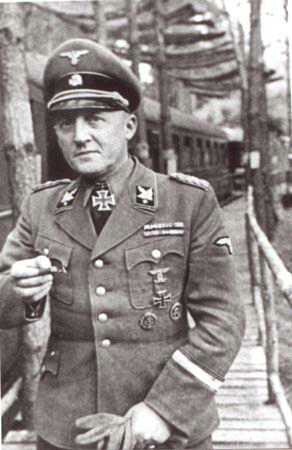
 0
0 -
Thanks for posting that, David. The description of the badge case conjures up the sort of case one would expect although some sources state that there were no cases for these awards and that they were delivered in ordinary jewellers' boxes. I find that hard to believe. John Angolia refers to Generalfeldmarschall Sperrle's badge but the badge shown is Hermann G?ring's example, acquired in London by Eric Campion and now owned by Chris Ailsby.
There was apparently a casette for the document, as this photograph from The Ruptured Duck website shows. Other photos can be viewed by clicking here. Returning to the case described by John Angolia, it may have been a Perchermeier case - if his recollection was reliable - but it does not follow that Hermann G?ring commissioned the A-St?ck badges from the Perchermeier firm. There again, Perchermeier name appears on a couple of lists of pre-1945 medals and orders suppliers. It's not a very common name and there is a Siegfried Perchermeier currently listed as a jeweller in Bad Reichenhall. That is less than twenty miles from Berchtesgaden, where Der Dicke had a house. Might be worth getting in touch with Siegfried Perchermeier and asking him if his family firm made things for G?ring.
PK
0 -
Here is the most complete list of known recipients to date:
ANGERSTEIN, Karl
D?NITZ, Karl
HIMMLER, Heinrich
DIETRICH, Sepp
HARTMANN, Erich
Von BLOMBERG, Werner
HARLINGHAUSEN, Martin
Von BRAUCHITSCH, Walter
GALLAND, Adolf
BAUMBACH, Werner
G?RING, Hermann
JESCHONNEK, Hans
BODENSCHATZ, Karl
Ritter Von GREIM, Robert
KORTEN, G?nter
BAUR, Hans
GRAFF, Hermann
KELLER, Alfred
Von BELOW, Nicolaus
GOLLOB, Gordon
KESSELRING, Albert
CHRISTIANSEN, Friedrich
Von GABLENS, Carl - August
KAMMHUBER, Josef
KASTNER - KIRDORF, Gustav
PARANI, Albert
STUDENT, Kurt
LOHR, Alexander
PELTZ, Friedrich
TRETTNER, Heinrich
LENT, Helmut
PFLUGBEIL, Johanus
UDET, Ernst
LOERZER, Bruno
ROMMEL, Erwin
RAMCKE, Bernard
WEVER, Walther
M?LDERS, Werner
Von RICHTHOFEN, Wolfram
REITSCH, Hanna
SKORZENY, Otto
MILCH, Erhard
SPERRLE, Hugo
NAVRATIL, Frederick
NOWOTHY, Walter
STUMPFF, Hans-Jurgen
von MANSTEIN, Erich
RUDEL, Hans - Ulrich
SCHNAUFER, Helmut
Foreign recipients:
BORIS, King of Bulgaria
MUSSOLINI, Benito
VUILLEMIN General
MORAGILIA General d Asti? de la V?gerie Colonel
PETITJEAN Colonel de Geffri?r Commandent (Mej?r)
SCHMIDLEIN Capitaine
ANTONESCU, Ion
HORTHY, Niklos
BALBO, Italo
VALLE, Ugo
FRANCO, Francisco
von MANNERHEIM, Carl Gustav Emil, Baron
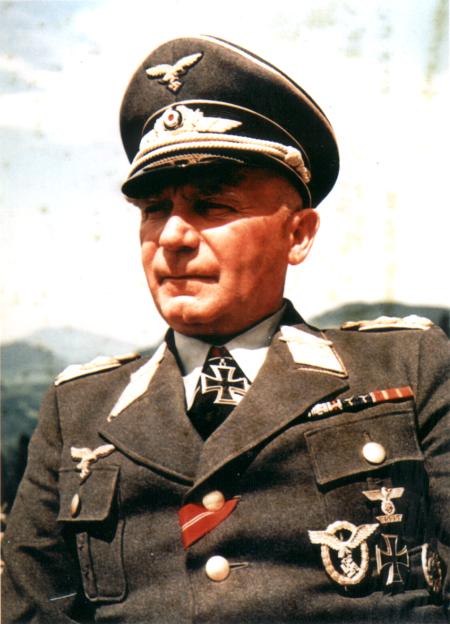
That makes sixty-one badges. Charles Lindbergh is said by some to have been given the badge but I haven't found any verifiable references to this. Mind you, he would have been a perfect candidate from G?ring's point of view. General Dessloch isn't listed as having receiving the Combined Pilot-Observer Badge with Diamonds. Yet that really looks like a B-St?ck badge in the photograph. Unless I am mistaken, the swastika even appears to have lost some stones. So, assuming Dessloch was a recipient, that takes it to sixty-two known investitures. There is also a photograph of General Dietl wearing a PO Badge with Diamonds, which takes us to sixty-three known holders.
PK
0 -
Hans-Ulrich Rudel wearing his badge. Reflecting on Dave Danner's comment, the badge sold by Niemann for $60k might not be the same as the badge attributed to Erhard Milch by Wolfe-Hardin but one thing is certain: neither of them resembles the known, original A-St?ck badges shown here.
PK

 0
0 -
Yeah, well, these guys get so many of these things through their hands each week that they're bound to make mistakes from time to time. Mind you, it works both ways: a mate of mine bought a genuine Zimmermann RK from a top dealer the other day for ?50. The guy handles so many Ritterkreuze that he mistook it for a Latvian fake.
PK
0 -
Stu,
Don't be discouraged! It doesn't take long to absorb the basics. And you have the right attitude as well. Which is why those of us who have been close to these things for years will always be happy to help. Not that we're all infallible! I learn something new every day. Did you post that Godet 1870 EK2 somewhere? I'd like to see it.
PK
0 -
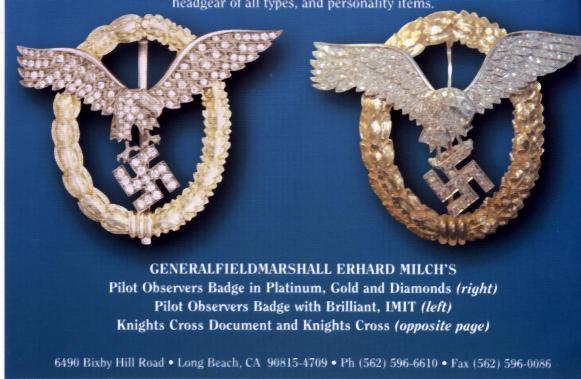
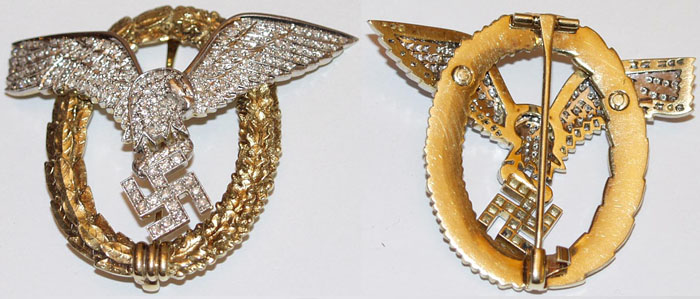
Looking at the lower edge of the eagle's left wing - to the right as we view the photos - I see a similarity between the A-St?ck reportedly sold by Detlev Niemann for ?60,000.00 and the A-St?ck attributed by Wolfe-Hardin to Erhard Milch.
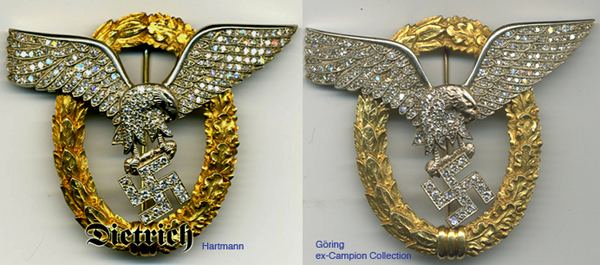
Looking at the Hartmann and G?ring badges, the way in which this part of the eagle's wing is formed is quite different to the outline presented by the badges proposed by Niemann and Wolfe-Hardin. This cannot be said to be due to handfinishing with files because the wings were fashioned as frames to function as settings for the stones.
Bill Stump was certain about one thing: he believed the B-St?ck badges to have been made by Rudolf St?biger of Vienna and that the A-St?ck badges were made by German jewellers. Given that the badges are clearly different in terms of details like the shape of the eagles' wings and the fact that the B-St?ck wearing copies accepted as originals bear St?biger's hallmark, this seems reasonable. We can dismiss the Skorzeny, engraved "Milch" and Sperrle badges as fakes on the basis of the benchmark afforded by the Hartmann badge. So what are we to think of the two badges proposed by Messrs Wolfe and Hardin and by Herr Niemann when we study the various photographs and scans posted in this thread? Different jewellers between 1935 and 1945? Or are we looking at postwar copies?
PK
0





IRISH 1916 IRA SET On EBAY
in Northern European & Baltic States
Posted · Edited by PKeating
Fascinating information, Brendan! There is, by the way, no problem with resurrecting old threads if you have new information pertaining to the subject matter.
You said what I hesitated to say, that it is actually very hard to ascertain the participation of someone in the 1916 Uprising, to say nothing of the War of Independence (aka Anglo-Irish War) and the Civil War. In rare cases where a veteran was known and there is supporting documentation, it is a different matter but what is to stop some intelligent, talented forger from creating 1916 groups from scratch, with original medals, when prices in excess of ?20,000.00 provide the incentive?
I have seen very cleverly faked German WW2 Knight's Cross or elite unit groups bought by fairly experienced collectors who only found out by chance, because of some anomaly or error in the documents, spotted by an informed third party. With an Irish 1916 group, it would appear that one could fabricate a participant, using some genuine period letters, a pension book from the 1940s or 1950, an old driving licence, and a few other things, with a few additions and enhancements indicating that he was in Boland's or some such place during the fighting, along with a photo of a couple of old geezers wearing their 1941-issue medals, and a pair of original medals. Outlay? Well, prices have risen so the 1916 medal would cost a bit but let's say our forger lays out a total of three or four grand in cash, along with his time. The 400% to 500% profit makes it viable.
As you so rightly point out, in addition, who can say if a man who genuinely received a medal or the two medals in the 1940s was a genuine veteran? In a few documented cases, where the chap was known and people attested to his participation, one can be sure but how many such cases are there? A lot of the real Men of 1916 never had medals. Nor did many of the fellows involved in the War of Independence and the Civil War. I knew many of them as a kid in Dublin in the 1960s. I remember one of them, at my parents' house in Upper Mount Street in 1966, just after the unveiling of the Wolfe Tone Memorial which my father designed, making sneering remarks about the massed ranks of "veterans" who turned up to hear Eamonn de Valera's speech. As far as he and his mates were concerned, they were what we now describe as "Walts". He was somewhat blunter in his terminology. And he was a Boland's veteran. He's in some of the news photos. He really "was there".
Some idea of the strength and vehemence of their remarks can be gleaned from how clear my memory of it remains, even though I was just five years old at the time. Of course, as I grew older and more interested, I would ask them to tell me stories and, like all genuine veterans, they tended to steer clear of nasty stuff and "heroics". They preferred to remember the good times...but as good times were rather far and few between for them during the wars, they didn't have a lot to tell a young lad. One story Paddy - shan't give his surname here in case the medals he never bothered getting turn up at Whyte's! - told me concerned a young girl who turned up at Boland's asking for some bread, as all the bakers had closed up after selling out. The young girl was a great-aunt of mine by marriage and was able to confirm the incident.
This is not to say that all applicants for these medals were Walts and poseurs. They certainly weren't. But an alarming number of these medals appear to have been handed out to bullsh1tters. It's rather like French Resistance medals. I'm sure that were one to sit, say, thirty recipients down in a room to fill out a questionnaire related to things any real veteran would know, many would fail it and not because of encroaching senility! They wouldn't be able to tell you, for example, how to load or field-strip the sort of weapons their units used. It's like all these fake paratroopers one meets: when you pose some simple questions, they flunk the test. It's too late to address the issue where these Irish medals are concerned but I think anyone contemplating the purchase of such medals should be very wary, especially in the aftermath of the Whyte's' sales.
PK